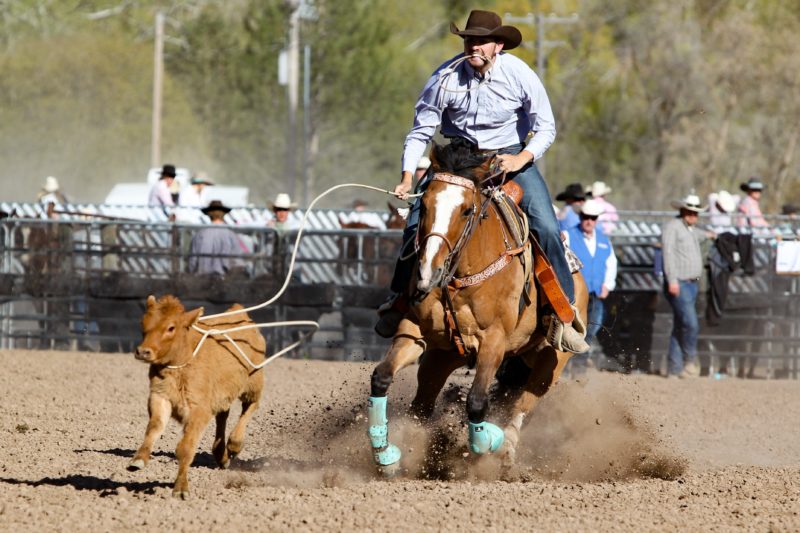The American Quarter Horse is one of the oldest recognized breeds of horse in the United States. The compact body is well suited to intricate and speedy maneuvers, making them great prospects for reining, cutting, barrel racing, calf roping, and other western riding sports. The American Quarter Horse (AQH) is also shown to participate in English disciplines and many other equestrian activities, but they are ultimately famed for their natural cow sense.

The breed’s original name changed throughout the years, but in 1940, the American Quarter Horse Association was formed and preserved the official name, the American Quarter Horse. The name was coined after one of their popular uses – competing in quarter-mile racing, one of the earliest forms of racing in America.
Fun Fact: The American Quarter Horse Association is the largest breed registry in the world.
The American Quarter Horse descends from the Spanish and English horses used in the American colonies in the 1600s. As mentioned, the Quarter Horse was known for its fast performance in quarter-mile races that the colonists held in Virginia and Rhode Island. Its sure-footedness and grace when running at such great speeds made it an early favorite among settlers. Later, the Quarter Horse played a great role in the American Frontier's westward expansion; the breed's endurance and agility proved irreplaceable to cowboys, pioneers, and farmers, as well as those who needed reliable, stable transportation in tough terrain.
Major Breed Categories:
-
Bulldog type:Generally used as a working ranch horse; has very good stamina and a strong build, especially in the legs.
-
Thoroughbred type: Sleek, fine bones, strong muscle structure and an elegant head. The Thoroughbred type can also be separated into two categories: The Semi-BulldogQuarter Horse (suitable for western events) and the Running Quarter Horse (one of the best breeds for running events).
-
Intermediate or the Progressive Quarter Horse: Represents a combination of the previous categories. This type comes with strong muscles, good bones, a full jowl, muscular neck and a rather short rear-side. A very versatile type, these horses are suited for both English and Western events.
Coat Variations
Quarter Horses come in a variety of solid colors, roans, palominos, grays, grullo’s, buckskins, and duns. Spotted horses and pintos are also accepted in the AQHA registry, as long as owners can prove that both the sires and dams of their horses were registered Quarter Horses. Markings such as stockings, stars, stripes, and blazes are common.
Did you know? Some Quarter Horses have been clocked galloping at up to 55 MPH!
 The breed’s original name changed throughout the years, but in 1940, the American Quarter Horse Association was formed and preserved the official name, the American Quarter Horse. The name was coined after one of their popular uses – competing in quarter-mile racing, one of the earliest forms of racing in America.
Fun Fact: The American Quarter Horse Association is the largest breed registry in the world.
The American Quarter Horse descends from the Spanish and English horses used in the American colonies in the 1600s. As mentioned, the Quarter Horse was known for its fast performance in quarter-mile races that the colonists held in Virginia and Rhode Island. Its sure-footedness and grace when running at such great speeds made it an early favorite among settlers. Later, the Quarter Horse played a great role in the American Frontier's westward expansion; the breed's endurance and agility proved irreplaceable to cowboys, pioneers, and farmers, as well as those who needed reliable, stable transportation in tough terrain.
The breed’s original name changed throughout the years, but in 1940, the American Quarter Horse Association was formed and preserved the official name, the American Quarter Horse. The name was coined after one of their popular uses – competing in quarter-mile racing, one of the earliest forms of racing in America.
Fun Fact: The American Quarter Horse Association is the largest breed registry in the world.
The American Quarter Horse descends from the Spanish and English horses used in the American colonies in the 1600s. As mentioned, the Quarter Horse was known for its fast performance in quarter-mile races that the colonists held in Virginia and Rhode Island. Its sure-footedness and grace when running at such great speeds made it an early favorite among settlers. Later, the Quarter Horse played a great role in the American Frontier's westward expansion; the breed's endurance and agility proved irreplaceable to cowboys, pioneers, and farmers, as well as those who needed reliable, stable transportation in tough terrain.






















